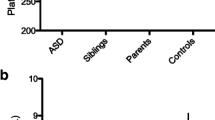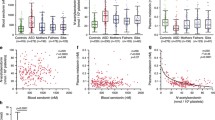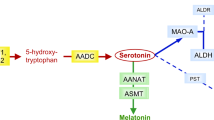Abstract
Experiments were conducted to determine the possibility of predicting a diagnosis of autism on the basis of an abnormally high release of14C-5-hydroxy-tryptamine from 5-HT loaded blood platelets of children. Such increased 5-HT release was previously reported by the authors for blood platelets of children diagnosed as autistic according to the Rimland E-2 score. The platelets of 10 psychotic children (including a number of subjects diagnosed as autistic by the E-2 score) were examined without knowledge of the diagnosis, in order to determine whether the biochemical results correlated with the E-2 score. On the basis of experimental data it was possible to predict that six children were autistic and four were nonautistic psychotics. According to the E-2 score, seven children were autistic and three nonautistic psychotics. The authors conclude that there is a correlation between a diagnosis of infantile autism by the E-2 score and enhanced release of radioactive 5-HT from 5-HT-loaded blood plateletsin vitro.
Similar content being viewed by others
References
Boullin, D. J., Coleman, M., & O'Brien, R. A. Abnormalities in platelet 5-hydroxytryptamine efflux in patients with infantile autism.Nature, 1970,226, 371–372.
Boullin, D. J., & O'Brien, R. A. The accumulation of guanethidine by human blood platelets.British Journal of Pharmacology and Chemotherapy, 1969,35, 90–102.
Boullin, D. J., & O'Brien, R. A. Accumulation of dopamine by blood platelets from normal subjects and parkinsonian patients under treatment with L-dopa.British Journal of Pharmacology and Chemotherapy, 1970,39, 779–788.
Boullin, D. J., & O'Brien, R. A. Abnormalities of 5-hydroxytryptamine uptake and binding by blood platelets from children with Down's syndrome.Journal of Physiology, 1971,212, 287–298.
Holmsen, H., Day, H. J., & Storm, E. Adenine nucleotide metabolism of blood platelets. VI. Subcellular localization of nucleotide pools with different functions in the platelet release reaction.Biochimica et Biophysica Acta, 1966,186, 254–266.
Ireland, D. M. Effect of thrombin on the radioactive nucleotides of human washed platelets.Biochemical Journal, 1967,105, 857–867.
Judd, L. L., & Mandell, A. J. Chromosome studies in early infantile autism.Archives of General Psychiatry, 1968,18, 450–457.
Kanner, L. Autistic disturbances of affective contact.Nervous Child, 1943,2, 217–250.
Ornitz, E. M., Ritvo, E. R., Panman, L. M., Lee, Y. H., Carr, E. M., & Walter, R. D. The auditory-evoked response in normal and autistic children during sleep.Electroencephalography and Clinical Neurophysiology, 1968,25, 221–230.
Paasonen, M. K. Platelet 5-hydroxytryptamine as a model in pharmacology.Annales Medicinae Experimentalis et Biologiae Fenniae, 1968,46, 416–422.
Pletscher, A. Metabolism, transfer and storage of 5-hydroxytryptamine in blood platelets.British Journal of Pharmacology and Chemotherapy, 1968,32, 1–16.
Rimland, B.Infantile Autism. New York: Meredith, 1964, p. 87.
Rimland, B. On the objective diagnosis of infantile autism.Acta Paedopsychiatrica (Basel), 1968,35, 146–161.
Rimland, B. High dosage levels of certain vitamins in the treatment of children with severe mental disorders. In D. R. Hawkins & L. C. Pauling (Eds.),Orthomolecular Psychiatry. W. H. Freeman, 1971 (in press).
Ritvo, E. R., Ornitz, E. M., Eviatar, A., Markham, C. H., Brown, M. B., & Mason, A. Decreased postrotatory nystagmus in early infantile autism.Neurology, 1969,19, 653–658.
Schain, R. J., & Freedman, D. X., Studies on 5-hydroxyindole metabolism in autistic and other mentally retarded children.Journal of Pediatrics, 1961,58, 315–320.
Schain, R. J., & Yannet, H. Infantile autism, an analysis of 50 cases and a consideration of certain relevant neurophysiologic concepts.Journal of Pediatrics, 1960, 560–567.
Siva Sankar, D. V., Cates, N., Broer, H., & Sankar, D. B. Biochemical parameters of childhood schizophrenia (autism) and growth. In J. Wortis (Ed.),Recent Advances in Biological Psychiatry. Plenum Press, 1963,5, 76–83.
Author information
Authors and Affiliations
Additional information
This research was supported in part by National Institutes of Health Grant RR 00 284 and National Institute of Mental Health Grant HD 08429.
Rights and permissions
About this article
Cite this article
Boullin, D.J., Coleman, M., O'Brien, R.A. et al. Laboratory predictions of infantile autism based on 5-hydroxytryptamine efflux from blood platelets and their correlation with the rimland E-2 score. J Autism Dev Disord 1, 63–71 (1971). https://doi.org/10.1007/BF01537743
Issue Date:
DOI: https://doi.org/10.1007/BF01537743




